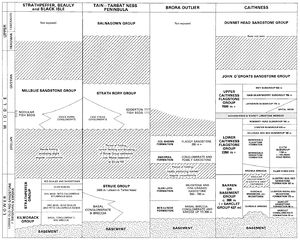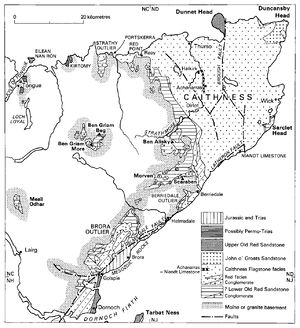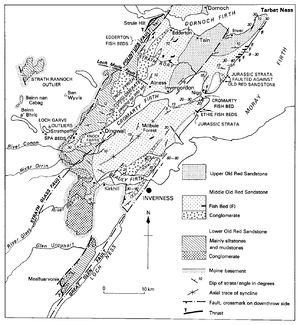Upper Old Red Sandstone, Northern Highlands of Scotland: Difference between revisions
m (Text replacement - "'''From: Johnstone, G S and Mykura, W. 1989. British regional geology: the Northern Highlands of Scotland (4th edition). (Nottingham: British Geological Survey.)'''" to "{{NHRG}}") |
|||
| Line 1: | Line 1: | ||
{{NHRG}} | |||
== Upper Old Red Sandstone == | == Upper Old Red Sandstone == | ||
[[File:P915488.jpg|thumbnail|Correlation shart of the Old red Sandstone of the Northern Highlands. P915488.]] | [[File:P915488.jpg|thumbnail|Correlation shart of the Old red Sandstone of the Northern Highlands. P915488.]] | ||
Latest revision as of 11:54, 1 February 2018
| Johnstone, G S and Mykura, W. 1989. British regional geology: Northern Highlands of Scotland. Fourth edition. Keyworth, Nottingham: British Geological Survey. |
Upper Old Red Sandstone



The only Caithness rocks classed as Upper Old Red Sandstone are the sandstones of the Dunnet Head Sandstone Group (P915488). The sandstones are lithologically similar to the Hoy Sandstone of Orkney; they are pink and yellow, cross-stratified, predominantly medium-grained with scattered pebbles and thin intercalations of red mudstone and shale. Trough cross-bedding is very common and many sections display slump-bedding, convolute bedding and miniature water-ejection structures. Sun cracks are common in the shaly beds and many sandstone sets contain chips of red and purple siltstone and shale. At certain horizons calcareous concretions are present, possibly marking the positions of incipient fossil soils. The sandstones have yielded scales of Holoptychius sp. (Halliday and others, 1977). The beds were probably laid down in a fluvial environment, possibly by braided rivers entering the area from the west.
In Easter Ross and east Sutherland (P915486, P915487) sediments of Upper Old Red Sandstone age crop out in the axial region of the Inver–Black Isle Syncline within the Tarbat Ness peninsula where they have been termed the Balnagown Group (Armstrong, 1977). They also form a narrow coastal strip north of Dornoch (P915486). They consist of yellow and red, medium-grained, cross-bedded sandstone with scattered pebbles, and appear to be entirely of fluvial origin. No fish-bearing calcareous siltstones are present, but isolated Fish-scales have been recorded at a number of localities. At Embo, north of Dornoch, Holoptychius sp. has been found, and Traquair (1896, p.260) identified Psammosteus taylori from a stream near Balnagown (6 km south of Tain).